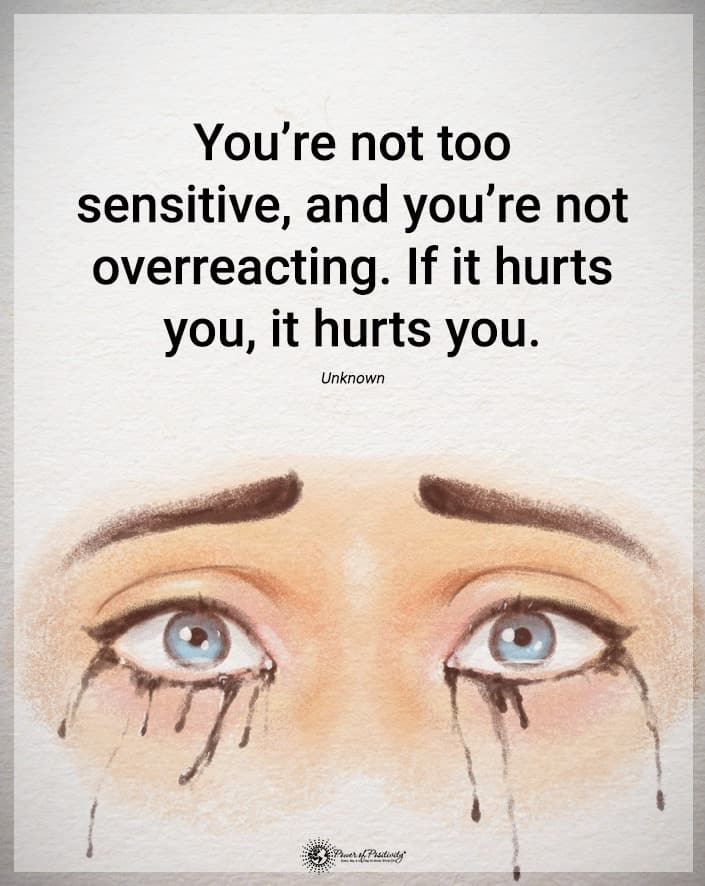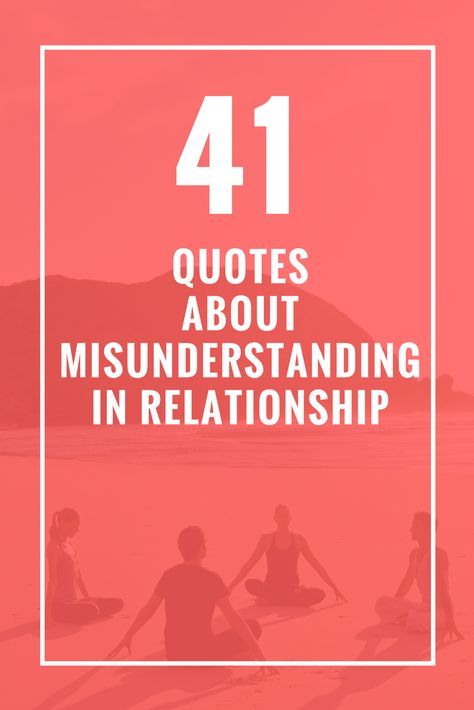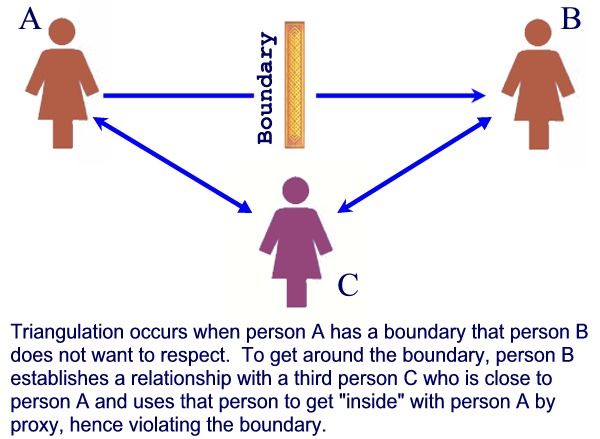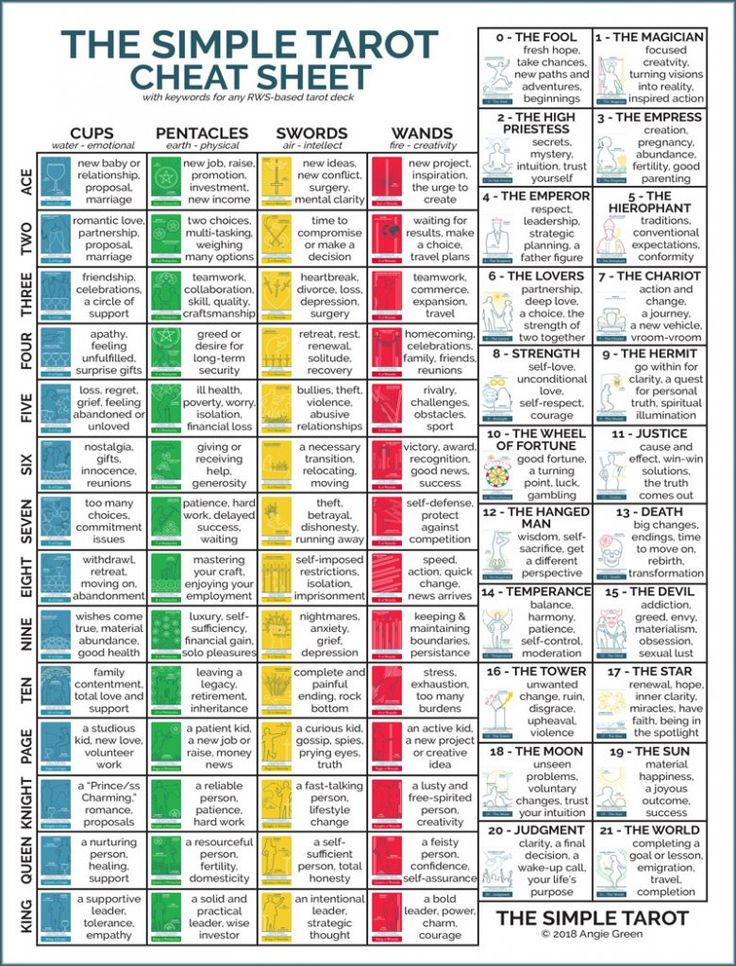The benefits of crying
9 Benefits of Crying and Why It's Good and When to Get Help
Overview
Crying is a common human action, and it can be triggered by many different emotions. But why do humans cry?
Researchers have found that crying can benefit both your body and your mind, and these benefits begin at birth with a baby’s first cry. Keep reading to learn more about the health benefits of crying.
There are three different types of tears:
- reflex tears
- continuous tears
- emotional tears
Reflex tears clear debris, like smoke and dust, from your eyes. Continuous tears lubricate your eyes and help protect them from infection. Emotional tears may have many health benefits. Whereas continuous tears contain 98 percent water, emotional tears contain stress hormones and other toxins. Researchers have theorized that crying flushes these things out of your system, though more research is needed in this area.
Crying may be one of your best mechanisms to self-soothe. Researchers have found that crying activates the parasympathetic nervous system (PNS). The PNS helps your body rest and digest. The benefits aren’t immediate, however. It may take several minutes of shedding tears before you feel the soothing effects of crying.
Crying for long periods of time releases oxytocin and endogenous opioids, otherwise known as endorphins. These feel-good chemicals can help ease both physical and emotional pain. Once the endorphins are released, your body may go into somewhat of a numb stage. Oxytocin can give you a sense of calm or well-being. It’s another example of how crying is a self-soothing action.
Along with helping you ease pain, crying, specifically sobbing, may even lift your spirits. When you sob, you take in many quick breaths of cool air. Breathing in cooler air can help regulate and even lower the temperature of your brain. A cool brain is more pleasurable to your body and mind than a warm brain. As a result, your mood may improve after a sobbing episode.
If you’re feeling blue, crying is a way to let those around you know you are in need of support. This is known as an interpersonal benefit. From the time you were a baby, crying has been an attachment behavior. Its function is in many ways to obtain comfort and care from others. In other words, it helps to build up your social support network when the going gets tough.
Grieving is a process. It involves periods of sorrow, numbness, guilt, and anger. Crying is particularly important during periods of grieving. It may even help you process and accept the loss of a loved one.
Everyone goes through the grieving process in different ways. If you find that your crying is extreme or starting to interfere with your everyday life, it might be a good idea to check in with your doctor.
Learn more: Why can’t I stop crying? »
Crying doesn’t only happen in response to something sad. Sometimes you may cry when you are extremely happy, scared, or stressed. Researchers at Yale University believe crying in this way may help to restore emotional equilibrium. When you’re incredibly happy or scared about something and cry, it may be your body’s way to recover from experiencing such a strong emotion.
Researchers at Yale University believe crying in this way may help to restore emotional equilibrium. When you’re incredibly happy or scared about something and cry, it may be your body’s way to recover from experiencing such a strong emotion.
A baby’s very first cry out of the womb is a very important cry. Babies receive their oxygen inside the womb through the umbilical cord. Once a baby is delivered, they must start breathing on their own. The first cry is what helps a baby’s lungs adapt to life in the outside world.
Crying also helps babies clear out any extra fluid in the lungs, nose, and mouth.
Learn more: How do babies breathe in the womb? »
Crying may also help babies sleep better at night. In a small study on infant sleep, 43 participants used graduated extinction, also known as controlled crying, to put their babies down to bed. With controlled crying, babies were left to cry for a set number of minutes before intervention from their parents.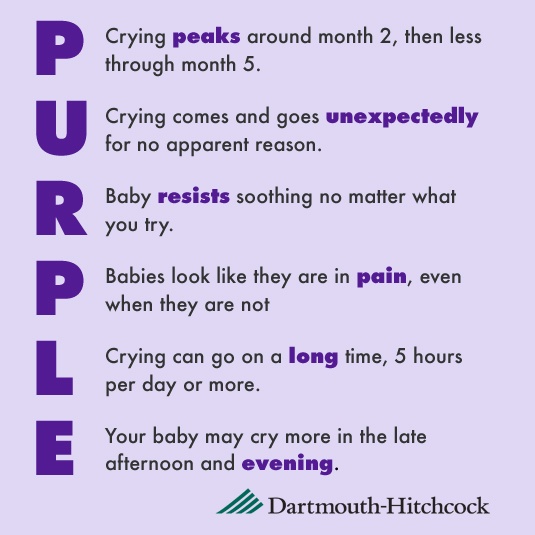 The crying increased both the sleep length and reduced the number of times the infants woke during the night. A year later, the crying did not appear to increase stress in the infants or negatively impact the parent-child bond.
The crying increased both the sleep length and reduced the number of times the infants woke during the night. A year later, the crying did not appear to increase stress in the infants or negatively impact the parent-child bond.
Crying in response to something that makes you happy or sad is normal and healthy. Don’t shy away from shedding tears if you feel the need to release. Excessive crying is something you should chat about with your doctor, however. If crying starts to interfere with your everyday activities, it may be a sign of depression.
Other symptoms of depression include:
- feelings of sadness or hopelessness
- feelings of irritability or frustration
- changes in appetite, or weight loss or gain
- lack of energy
- trouble sleeping or sleeping too much
- unexplained aches or pains
- thoughts of death or suicide
If you have thoughts of self-harm, call your local emergency services. If you live in the United States, you can also call the National Suicide Prevention Lifeline at 988.
How much should you cry?
Researchers at Tilburg University put crying under the microscope. Their results? On average, American women cry 3.5 times each month while American men cry around 1.9 times each month. The averages by country vary considerably. The average in America is on the higher end of the spectrum. Women in China, for example, only cry about 1.4 times each month. Men in Bulgaria reportedly cry a mere 0.3 times each month.
It’s OK to cry. It may even be beneficial to you. If you feel the need to cry, don’t hold back your tears. Tears are a normal, healthy way to express emotion.
Is crying good for you?
It’s safe to say that 2020 gave us more than enough to cry about. Yet even prior to last year, it seems that we were crying fairly often. Researchers note that, on average, American women cry 3.5 times each month, while American men cry about 1.9 times each month. These figures may take some of us by surprise, especially as our society has often looked at crying — particularly by men — as a sign of weakness and lack of emotional stamina.
Health benefits of crying
As a phenomenon that is unique to humans, crying is a natural response to a range of emotions, from deep sadness and grief to extreme happiness and joy. But is crying good for your health? The answer appears to be yes. Medical benefits of crying have been known as far back as the Classical era. Thinkers and physicians of ancient Greece and Rome posited that tears work like a purgative, draining off and purifying us. Today’s psychological thought largely concurs, emphasizing the role of crying as a mechanism that allows us to release stress and emotional pain.
Crying is an important safety valve, largely because keeping difficult feelings inside — what psychologists call repressive coping — can be bad for our health. Studies have linked repressive coping with a less resilient immune system, cardiovascular disease, and hypertension, as well as with mental health conditions, including stress, anxiety, and depression. Crying has also been shown to increase attachment behavior, encouraging closeness, empathy, and support from friends and family.
Not all tears are created equal
Scientists divide the liquid product of crying into three distinct categories: reflex tears, continuous tears, and emotional tears. The first two categories perform the important function of removing debris such as smoke and dust from our eyes, and lubricating our eyes to help protect them from infection. Their content is 98% water.
It’s the third category, emotional tears (which flush stress hormones and other toxins out of our system), that potentially offers the most health benefits. Researchers have established that crying releases oxytocin and endogenous opioids, also known as endorphins. These feel-good chemicals help ease both physical and emotional pain. Popular culture, for its part, has always known the value of a good cry as a way to feel better — and maybe even to experience physical pleasure. The millions of people who watched classic tearjerker films such as West Side Story or Titanic (among others) will likely attest to that fact.
Rethinking crying in boys and men
“I know a man ain’t supposed to cry,” goes the lyric of a popular song, “but these tears I can’t hold inside.” These words succinctly summarize many a man’s dilemma about emotional expression. From early on, boys are told that real men do not cry. When these boys grow up, they may stuff their feelings deep inside and withdraw emotionally from their loved ones, or self-medicate with alcohol or drugs, or even become suicidal. Many men therefore need to learn the skills of how to reconnect with their emotions. Back in the 1990s, the poet Robert Bly led men’s seminars at which he taught the participants how to get in touch with their long-buried feelings of sadness and loss, and to weep openly if they needed to. Ideally, however, such education should begin early on, at home or at school, with adults making it safe for boys to talk about difficult feelings.
Crying during COVID
As of this writing, the nation has registered over 500,000 deaths from COVID-19. The collective grief over these losses can only be described as staggering. It is no surprise, then, that at times like these our feelings are closer to the surface, and that many people who were not previously prone to crying find themselves tearing up more easily. In fact, as one medical professional put it, showing emotion in public may have become a new normal.
The collective grief over these losses can only be described as staggering. It is no surprise, then, that at times like these our feelings are closer to the surface, and that many people who were not previously prone to crying find themselves tearing up more easily. In fact, as one medical professional put it, showing emotion in public may have become a new normal.
When are tears a problem?
There are times when crying can be a sign of a problem, especially if it happens very frequently and/or for no apparent reason, or when crying starts to affect daily activities or becomes uncontrollable. Conversely, people suffering from certain kinds of clinical depression may actually not be able to cry, even when they feel like it. In any of these situations, it would be best to see a medical professional who can help diagnose the problem and suggest appropriate treatment.
Takeaways
As challenging as it may be, the best way to handle difficult feelings, including sadness and grief, is to embrace them.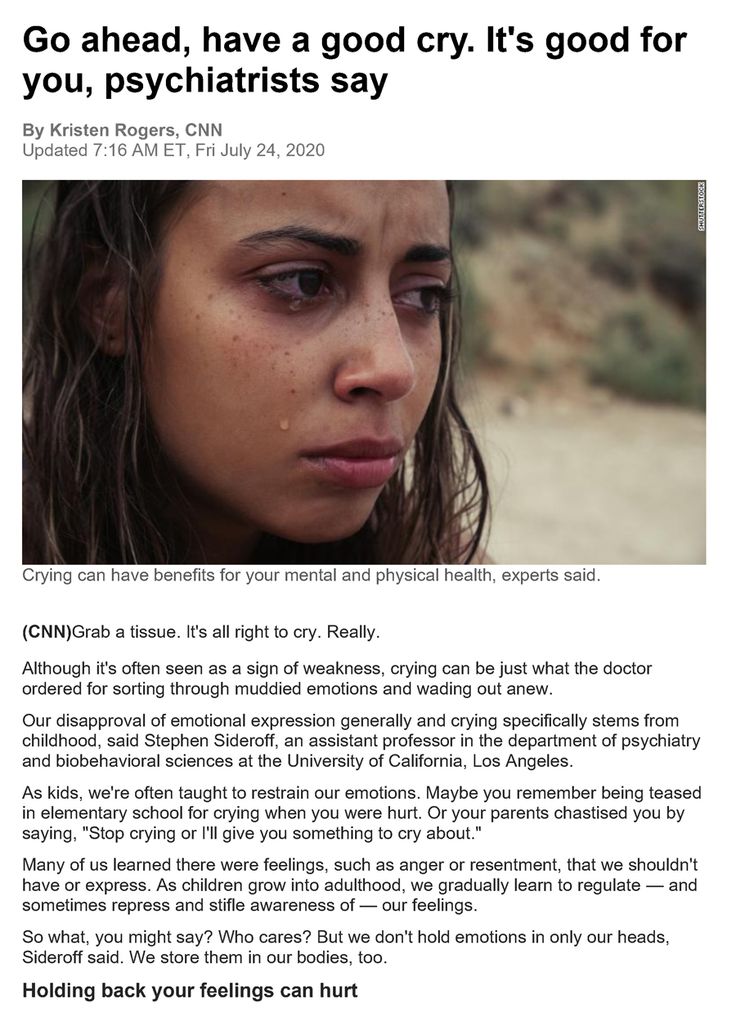 It is important to allow yourself to cry if you feel like it. Make sure to take the time and find a safe space to cry if you need to. Many people associate crying during grief with depression, when it can actually be a sign of healing. Teaching boys and young men that it’s okay to cry may reduce negative health behaviors and help them have fuller lives.
It is important to allow yourself to cry if you feel like it. Make sure to take the time and find a safe space to cry if you need to. Many people associate crying during grief with depression, when it can actually be a sign of healing. Teaching boys and young men that it’s okay to cry may reduce negative health behaviors and help them have fuller lives.
If crying becomes overwhelming or uncontrollable, see a doctor or mental health professional for evaluation and treatment.
Why is it good to cry? | Shchotizhnevik PHARMACY
Many have had a good cry in life due to problems at work or in relationships with loved ones. However, how does this affect the state of human health and is there any benefit in such a manifestation of emotions? In general, a person secretes about 300 ml of tear fluid per day and about 38 liters per year. These tears can be basal, reflex and, finally, psychological, that is, associated with the manifestation of emotions.
1. Removal of toxins. Crying can not only "cleanse" our thoughts, but also the body. For example, tears that are produced when spitting out emotions help the body get rid of chemicals that increase the level of cortisol, the stress hormone. According to the results of a clinical study, crying, along with exocrine processes such as exhalation, urination and sweating, allows the body to get rid of toxic substances. In addition, emotional crying is also associated with an increase in the levels of the following chemicals: prolactin, adrenocorticotropic hormone, endorphin, and leucine-enkephalin, which help reduce pain. nine0003
Crying can not only "cleanse" our thoughts, but also the body. For example, tears that are produced when spitting out emotions help the body get rid of chemicals that increase the level of cortisol, the stress hormone. According to the results of a clinical study, crying, along with exocrine processes such as exhalation, urination and sweating, allows the body to get rid of toxic substances. In addition, emotional crying is also associated with an increase in the levels of the following chemicals: prolactin, adrenocorticotropic hormone, endorphin, and leucine-enkephalin, which help reduce pain. nine0003
2. Bacteria control. Crying is also a good way to fight bacteria. Tears contain lysozyme, a component also found in other biological fluids such as breast milk, semen, and saliva, which contributes to the death of many bacteria in a short period of time. This is due to its destructive effect on the cell walls of bacteria. So, according to the results of a study published in the journal Food Microbiology, tears have good antimicrobial properties and can have a detrimental effect on a wide range of microorganisms. nine0003
nine0003
3. Improved vision. Tears can clear vision by moisturizing the eyeball and eyelids. When the lining of the eye is dehydrated, vision becomes a little blurry. In addition, tear fluid allows you to remove dust and debris from the organ of vision. Crying also prevents dehydration of various mucous membranes.
4. Improvement of mood. Crying is a well-known antidepressant. According to the results of a study by scientists from the University of South Florida (University of South Florida), USA, it itself is able to elevate mood and reduce the severity of symptoms of depression. So, shed tears improved the mood of almost 90% of participants compared to 8% of those who reported feeling worse after crying. In this context, it is worth noting that individuals with anxiety or affective disorders were less likely to experience the positive effects of crying.
5. Relieve stress. Tears can help provide a sense of moral relief, even if problems have not been resolved. They help to reduce the stress hormone in the body, which reduces moral stress, which, as you know, can cause headaches, increase blood pressure. Crying provides an emotional release of accumulated negative feelings, stress, and disappointments. In addition, he is able to express in relationships what is difficult to express in words. nine0003
Crying provides an emotional release of accumulated negative feelings, stress, and disappointments. In addition, he is able to express in relationships what is difficult to express in words. nine0003
In this way, shedding tears can help to cope with both psychological and physiological problems.
Based on www.medicaldaily.com
Crying well - is it good for health?
- Jason Goldman
- BBC Future
Sign up for our 'Context' newsletter to help you understand what's going on.
Image Credit, iStock
There is a common belief that tears are a good way to relieve stress. Browser BBC Future wondered if this is true scientifically?
Until recently, scientists and writers sharply disagreed about the benefits of crying.
In his play "Henry VI" Shakespeare wrote: "Weeping weakens the bitterness of anguish", and the American writer Lemony Snicket noted that "if you cry well and for a long time, you will feel better, even if the situation has not changed at all. "
"
- Why people learned to cry
- Is it harmful to accumulate anger in oneself? nine0022
- Should the boss cry with you?
- Blood, sweat and tears: the secrets of our secrets
On the other hand, Charles Darwin believed that the production of tears (regardless of the process of crying) was just a useless side effect of the muscles located around the eye.
In his opinion, these muscles must contract from time to time so as not to overflow with blood, and the release of tears is simply an accidental consequence of this physiological process that appeared in the process of evolution. nine0003
(However, Darwin admitted that crying helps babies get their parents' attention.)
We now know that crying (at least in adults) is a complex physiological response to certain emotional stimuli.
The main distinguishing feature of crying is the appearance of tears, but it is also accompanied by a change in facial expression and breathing rate.
So, for example, when we cry, we often sob, that is, we sharply inhale and exhale.
From a scientific point of view, this means that crying and producing tears in response to a chemical stimulus (for example, if you rub your eyes after eating something spicy) are two different things.
Even the tears themselves are different. In 1981, Minnesota psychiatrist William H. Frey II discovered that tears elicited by watching a sad movie contained more protein than those produced by a reaction to a freshly chopped onion.
Image copyright, iStock
Image caption,The exact reasons why we cry are still a mystery
Skip Podcast and continue reading.
Podcast
What was that?
We quickly, simply and clearly explain what happened, why it's important and what's next.
episodes
The End of the Story Podcast
At the same time, tears that come to the eyes from an excess of emotions can be caused not only by sadness.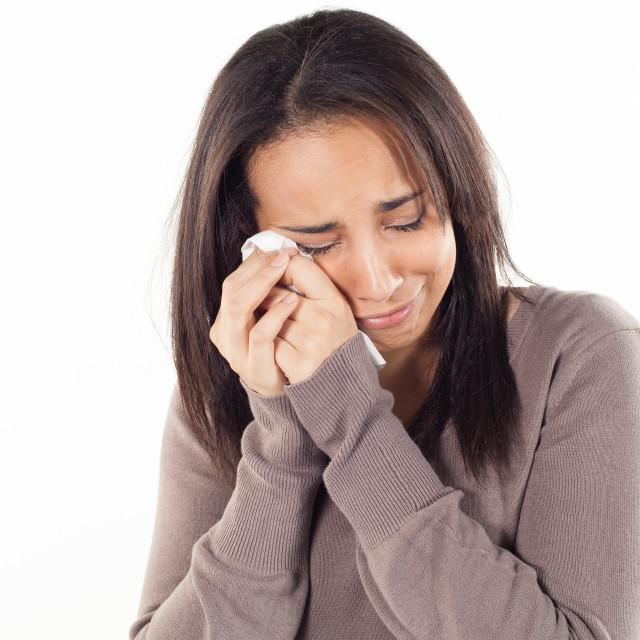
Anyone who has ever attended a hilarious comedy show or listened to the bride and groom read wedding vows to each other during the wedding will confirm this. nine0003
Many of us are familiar with a variety of reasons that can cause tears - both sad and joyful.
However, the reasons why we do this as adults are still not entirely clear. Scientists have many hypotheses about this.
One of them is that the crying of adults is not really that different from that of a child, at least as far as its social aspect is concerned.
In other words, crying is a way to get attention, get support and help from friends when we need it most. nine0003
Through crying, we can tell our loved ones about our feelings when there are not enough words to do so.
This may explain some types of crying, but scientists have repeatedly found that adults often cry when left alone.
Image copyright, iStock
Image caption, Crying alone can be one way of assessing one's emotional state and understand your own feelings. nine0003
nine0003
This is a rather controversial theory, suitable only for certain cases, although there are still some arguments in its favor.
One cannot ignore the concept of catharsis: crying helps us cope with situations that carry a great emotional load.
This idea is consonant not only with the words of Shakespeare, but also with the opinion of the Roman poet Ovid, who believed that "crying comforts, and grief dissolves in tears."
The Greek philosopher Aristotle wrote that crying "purifies the mind." nine0003
In a 1986 study of popular American magazines and newspapers, a psychologist found that 94% of articles about crying claimed that crying helped relieve emotional stress.
In 2008, a study was published in which 4,300 young people from 30 countries took part. Most of them said that after crying, they felt better both physically and emotionally.
At the same time, some participants did not notice any changes, while others felt even worse.